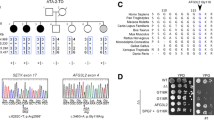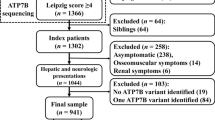Abstract
Familial cortical myoclonic tremor and epilepsy is a phenotypically and genetically heterogeneous autosomal dominant disorder characterized by the presence of cortical myoclonic tremor and epilepsy that is often accompanied by additional neurological features. Despite the numerous familial studies performed and the number of loci identified, there is no gene associated with this syndrome. It is expected that through the application of novel genomic technologies, such as whole exome sequencing and whole genome sequencing, a substantial number of novel genes will come to light in the coming years. In this study, we describe the identification of two disease-segregating mutations in a large family featuring cortical myoclonic tremor with epilepsy and parkinsonism. Due to the previous association of ACMSD deficiency with the development of epileptic seizures, we concluded that the identified nonsense mutation in the ACMSD gene, which encodes for a critical enzyme of the kynurenine pathway of the tryptophan metabolism, is the disease-segregating mutation most likely to be responsible for the phenotype described in our family. This finding not only reveals the identification of the first gene associated with familial cortical myoclonic tremor and epilepsy but also discloses the kynurenine pathway as a potential therapeutic target for the treatment of this devastating syndrome.
Key message
-
ACMSD is mutated in a family with cortical myoclonus, epilepsy, and parkinsonism.
-
ACMSD mutation contributes to the development of FCMTE
-
QA accumulation is likely to play an important role in the pathogenesis of FCMTE.
-
The kynurenine pathway as a potential drug target for the treatment of epilepsy.


Similar content being viewed by others
References
van Rootselaar AF, van Schaik IN, van den Maagdenberg AM, Koelman JH, Callenbach PM, Tijssen MA (2005) Familial cortical myoclonic tremor with epilepsy: a single syndromic classification for a group of pedigrees bearing common features. Mov Disord 20:665–673
Mikami M, Yasuda T, Terao A, Nakamura M, Ueno S, Tanabe H, Tanaka T, Onuma T, Goto Y, Kaneko S et al (1999) Localization of a gene for benign adult familial myoclonic epilepsy to chromosome 8q23.3-q24.1. Am J Hum Genet 65:745–751
Depienne C, Magnin E, Bouteiller D, Stevanin G, Saint-Martin C, Vidailhet M, Apartis E, Hirsch E, LeGuern E, Labauge P et al (2010) Familial cortical myoclonic tremor with epilepsy: the third locus (FCMTE3) maps to 5p. Neurology 74:2000–2003
de Falco FA, Striano P, de Falco A, Striano S, Santangelo R, Perretti A, Balbi P, Cecconi M, Zara F (2003) Benign adult familial myoclonic epilepsy: genetic heterogeneity and allelism with ADCME. Neurology 60:1381–1385
Striano P, Chifari R, Striano S, de Fusco M, Elia M, Guerrini R, Casari G, Canevini MP (2004) A new benign adult familial myoclonic epilepsy (BAFME) pedigree suggesting linkage to chromosome 2p11.1-q12.2. Epilepsia 45:190–192
Saint-Martin C, Bouteiller D, Stevanin G, Popescu C, Charon C, Ruberg M, Baulac S, LeGuern E, Labauge P, Depienne C (2008) Refinement of the 2p11.1-q12.2 locus responsible for cortical tremor associated with epilepsy and exclusion of candidate genes. Neurogenetics 9:69–71
Crompton DE, Sadleir LG, Bromhead CJ, Bahlo M, Bellows ST, Arsov T, Harty R, Lawrence KM, Dunne JW, Berkovic SF et al (2012) Familial adult myoclonic epilepsy: recognition of mild phenotypes and refinement of the 2q locus. Arch Neurol 69:474–481
Carr JA, van der Walt PE, Nakayama J, Fu YH, Corfield V, Brink P, Ptacek L (2007) FAME 3: a novel form of progressive myoclonus and epilepsy. Neurology 68:1382–1389
Yeetong P, Ausavarat S, Bhidayasiri R, Piravej K, Pasutharnchat N, Desudchit T, Chunharas C, Loplumlert J, Limotai C, Suphapeetiporn K et al (2013) A newly identified locus for benign adult familial myoclonic epilepsy on chromosome 3q26.32-3q28. Eur J Hum Genet 21:225–228
Merner ND, Girard SL, Catoire H, Bourassa CV, Belzil VV, Riviere JB, Hince P, Levert A, Dionne-Laporte A, Spiegelman D et al (2012) Exome sequencing identifies FUS mutations as a cause of essential tremor. Am J Hum Genet 91:313–319
Krebs CE, Paisan-Ruiz C (2012) The use of next-generation sequencing in movement disorders. Front Genet 3:75
Schwarcz R, Bruno JP, Muchowski PJ, Wu HQ (2012) Kynurenines in the mammalian brain: when physiology meets pathology. Nat Rev Neurosci 13:465–477
Stone TW, Darlington LG (2002) Endogenous kynurenines as targets for drug discovery and development. Nat Rev Drug Discov 1:609–620
Karkheiran S, Krebs CE, Makarov V, Nilipour Y, Hubert B, Darvish H, Frucht S, Shahidi GA, Buxbaum JD, Paisan-Ruiz C (2013) Identification of COL6A2 mutations in progressive myoclonus epilepsy syndrome. Hum Genet 132:275–283
Exome Variant Server (2012) NHLBI Exome Sequencing Project (ESP), Seattle, WA (URL: http://evsgswashingtonedu/EVS/) [06/2013]
Thusberg J, Olatubosun A, Vihinen M (2011) Performance of mutation pathogenicity prediction methods on missense variants. Hum Mutat 32:358–368
Guidetti P, Luthi-Carter RE, Augood SJ, Schwarcz R (2004) Neostriatal and cortical quinolinate levels are increased in early grade Huntington's disease. Neurobiol Dis 17:455–461
Lapin IP (1978) Stimulant and convulsive effects of kynurenines injected into brain ventricles in mice. J Neural Transm 42:37–43
Rahman A, Ting K, Cullen KM, Braidy N, Brew BJ, Guillemin GJ (2009) The excitotoxin quinolinic acid induces tau phosphorylation in human neurons. PLoS One 4:e6344
Wu HQ, Schwarcz R (1996) Seizure activity causes elevation of endogenous extracellular kynurenic acid in the rat brain. Brain Res Bull 39:155–162
Mori S, Bernardi R, Laurent A, Resnati M, Crippa A, Gabrieli A, Keough R, Gonda TJ, Blasi F (2012) Myb-binding protein 1A (MYBBP1A) is essential for early embryonic development, controls cell cycle and mitosis, and acts as a tumor suppressor. PLoS One 7:e39723
Lapin IP (1981) Kynurenines and seizures. Epilepsia 22:257–265
Amaral M, Outeiro TF, Scrutton NS, Giorgini F (2013) The causative role and therapeutic potential of the kynurenine pathway in neurodegenerative disease. J Mol Med (Berl) 91:705–713
Nalls MA, Plagnol V, Hernandez DG, Sharma M, Sheerin UM, Saad M, Simon-Sanchez J, Schulte C, Lesage S, Sveinbjornsdottir S et al (2011) Imputation of sequence variants for identification of genetic risks for Parkinson's disease: a meta-analysis of genome-wide association studies. Lancet 377:641–649
Magnin E, Vidailhet M, Ryff I, Ferreira S, Labauge P, Rumbach L (2012) Fronto-striatal dysfunction in type 3 familial cortical myoclonic tremor epilepsy occurring during aging. J Neurol 259:2714–2719
Sharifi S, Aronica E, Koelman JH, Tijssen MA, Van Rootselaar AF (2012) Familial cortical myoclonic tremor with epilepsy and cerebellar changes: description of a new pathology case and review of the literature. Tremor Other Hyperkinet Mov (N Y) 2:472–482
Liu X, Cheng R, Verbitsky M, Kisselev S, Browne A, Mejia-Sanatana H, Louis ED, Cote LJ, Andrews H, Waters C et al (2011) Genome-wide association study identifies candidate genes for Parkinson's disease in an Ashkenazi Jewish population. BMC Med Genet 12:104
Fukuoka S, Ishiguro K, Yanagihara K, Tanabe A, Egashira Y, Sanada H, Shibata K (2002) Identification and expression of a cDNA encoding human alpha-amino-beta-carboxymuconate-epsilon-semialdehyde decarboxylase (ACMSD). A key enzyme for the tryptophan-niacine pathway and “quinolinate hypothesis”. J Biol Chem 277:35162–35167
Fukuwatari T, Ohsaki S, Fukuoka S, Sasaki R, Shibata K (2004) Phthalate esters enhance quinolinate production by inhibiting alpha-amino-beta-carboxymuconate-epsilon-semialdehyde decarboxylase (ACMSD), a key enzyme of the tryptophan pathway. Toxicol Sci 81:302–308
Schwarcz R, Speciale C, French ED (1987) Hippocampal kynurenines as etiological factors in seizure disorders. Pol J Pharmacol Pharm 39:485–494
Arbatova J, D’Amato E, Vaarmann A, Zharkovsky A, Reeben M (2005) Reduced serotonin and 3-hydroxyanthranilic acid levels in serum of cystatin B-deficient mice: a model system for progressive myoclonus epilepsy. Epilepsia 46(Suppl 5):49–51
Striano P, D’Amato E, Pezzella M, Mainardi P, Zara F, Striano S (2010) Sudden death in Unverricht–Lundborg patients: is serotonin the key? Neurol Sci 31:115–116
Errichiello L, Pezzella M, Santulli L, Striano S, Zara F, Minetti C, Mainardi P, Striano P (2011) A proof-of-concept trial of the whey protein alfa-lactalbumin in chronic cortical myoclonus. Mov Disord 26:2573–2575
Pranzatelli MR, Tate E, Galvan I, Wheeler A (1996) A controlled trial of 5-hydroxy-L-tryptophan for ataxia in progressive myoclonus epilepsy. Clin Neurol Neurosurg 98:161–164
Vecsei L, Szalardy L, Fulop F, Toldi J (2013) Kynurenines in the CNS: recent advances and new questions. Nat Rev Drug Discov 12:64–82
Acknowledgments
We thank the patients and their families for participating in this study. This work is supported in part by the “Instituto de Salud Carlos III” (FIS PI10/02714; JFMM) and the National Institute of Neurological Disorders and Stroke of the National Institute of Health under award number R21NS082881 to CPR.
Conflict of interest
All authors declare they have no competing interest.
Author information
Authors and Affiliations
Corresponding authors
Electronic supplementary material
Below is the link to the electronic supplementary material.
ESM 1
(PDF 56 kb)
Rights and permissions
About this article
Cite this article
Martí-Massó, J.F., Bergareche, A., Makarov, V. et al. The ACMSD gene, involved in tryptophan metabolism, is mutated in a family with cortical myoclonus, epilepsy, and parkinsonism. J Mol Med 91, 1399–1406 (2013). https://doi.org/10.1007/s00109-013-1075-4
Received:
Revised:
Accepted:
Published:
Issue Date:
DOI: https://doi.org/10.1007/s00109-013-1075-4




